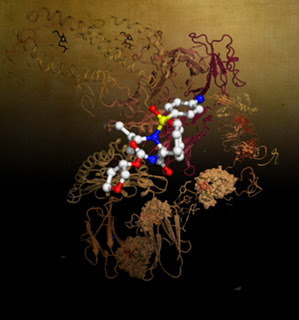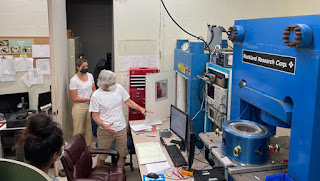The soft-yet-strong material, developed by a team at the University of Cambridge, looks and feels like a squishy jelly, but acts like an ultra-hard, shatterproof glass when compressed, despite its high water content.
The non-water portion of the material is a network of polymers held together by reversible on/off interactions that control the material’s mechanical properties. This is the first time that such significant resistance to compression has been incorporated into a soft material.
The ‘super jelly’ could be used for a wide range of potential applications, including soft robotics, bioelectronics or even as a cartilage replacement for biomedical use. The results are reported in the journal Nature Materials.
The way materials behave – whether they’re soft or firm, brittle or strong – is dependent upon their molecular structure. Stretchy, rubber-like hydrogels have lots of interesting properties that make them a popular subject of research – such as their toughness and self-healing capabilities – but making hydrogels that can withstand being compressed without getting crushed is a challenge.
“In order to make materials with the mechanical properties we want, we use crosslinkers, where two molecules are joined through a chemical bond,” said Dr Zehuan Huang from the Yusuf Hamied Department of Chemistry, the study’s first author. “We use reversible crosslinkers to make soft and stretchy hydrogels, but making a hard and compressible hydrogel is difficult and designing a material with these properties is completely counterintuitive.”
Working in the lab of Professor Oren A. Scherman, who led the research, the team used barrel-shaped molecules called cucurbiturils to make a hydrogel that can withstand compression. The cucurbituril is the crosslinking molecule that holds two guest molecules in its cavity – like a molecular handcuff. The researchers designed guest molecules that prefer to stay inside the cavity for longer than normal, which keeps the polymer network tightly linked, allowing for it to withstand compression.
Super jelly Credit: Zehuan Huang
“At 80% water content, you’d think it would burst apart like a water balloon, but it doesn’t: it stays intact and withstands huge compressive forces,” said Scherman, Director of the University’s Melville Laboratory for Polymer Synthesis. “The properties of the hydrogel are seemingly at o
dds with each other.”
“The way the hydrogel can withstand compression was surprising, it wasn’t like anything we’ve seen in hydrogels,” said co-author Dr Jade McCune, also from the Department of Chemistry. “We also found that the compressive strength could be easily controlled through simply changing the chemical structure of the guest molecule inside the handcuff.”
To make their glass-like hydrogels, the team chose specific guest molecules for the handcuff. Altering the molecular structure of guest molecules within the handcuff allowed the dynamics of the material to ‘slow down’ considerably, with the mechanical performance of the final hydrogel ranging from rubber-like to glass-like states.
“People have spent years making rubber-like hydrogels, but that’s just half of the picture,” said Scherman. “We’ve revisited traditional polymer physics and created a new class of materials that span the whole range of material properties from rubber-like to glass-like, completing the full picture.”
The researchers used the material to make a hydrogel pressure sensor for real-time monitoring of human motions, including standing, walking and jumping.
“To the best of our knowledge, this is the first time that glass-like hydrogels have been made. We’re not just writing something new into the textbooks, which is really exciting, but we’re opening a new chapter in the area of high-performance soft materials,” said Huang.
Researchers from the Scherman lab are currently working to further develop these glass-like materials towards biomedical and bioelectronic applications in collaboration with experts from engineering and materials science. The research was funded in part by the Leverhulme Trust and a Marie Skłodowska-Curie Fellowship. Oren Scherman is a Fellow of Jesus College.
Source/Credit: University of Cambridge
tn112521_01








































.jpg)
